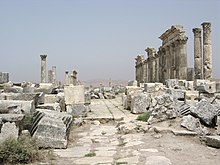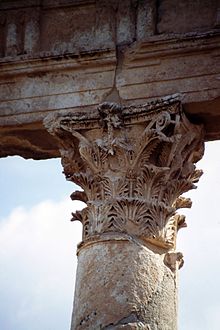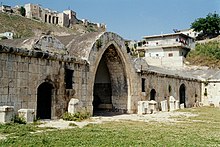Apamea, Syria
| Site notes | |
|---|---|
| Condition | ruins |
| Ownership | Public |
| Public access | Yes |
Apamea (
Amongst the impressive ancient remains, the site includes the Great Colonnade which ran for nearly 2 km (1.2 mi) making it among the longest in the Roman world and the Roman Theatre, one of the largest surviving theatres of the Roman Empire with an estimated seating capacity in excess of 20,000.
The site is about 55 km (34 mi) to the northwest of
History



Hellenistic era
After the conquest of the region by
After 142 BC, the pretender Diodotus Tryphon made Apamea the base of his operations.[4]
Q. Aemilius Secundus[5] did a population survey of the city and its territory which belonged to it in AD 6, in which he counted "117,000 hom(ines) civ(ium)" – 117,000 citizen human beings, a figure that has been interpreted as giving a total population of either 130,000 or 500,000, depending on methods used.[6]
In 64 BC,
Much of Apamea was destroyed in the 115 AD earthquake, but was subsequently rebuilt.
Roman era
From 218 until 234 AD, the legion
During the Byzantine–Sasanian War of 602–628, the city fell in 613 to Shahrbaraz and was in Sasanian hands until near the end of the war.[13]
Byzantine era
The Targum of Pseudo-Jonathan (Num. xxxiv. 11) has Apamea (אפמיאה)[14] for the city name Shepham as occurring in the Targumim Jerusalem and Neofiti.[15] Since Apamea virtually belonged to Rabbinic Palestine, the first-fruits brought by Ariston from that town were accepted for sacrifice in Jerusalem.[16]
Islamic era
Following the
It was settled by the Arab tribes of Bahra and Udhra. However, it only regained its importance under the rule of Aleppo-based Hamdanid dynasty.[12] Ruled by Khalaf ibn Mula'ib from 1095–1106, the city was taken by Tancred after Khalaf's murder by Assassins.[18] It was destroyed by an earthquake in 1152.[11]
Remains


Many remains of the ancient acropolis are still standing, consisting probably of the remains of highly decorated temples of which Sozomen speaks;[19] it is now enclosed in ancient castle walls called Kalat el-Mudik (Kŭlat el-Mudîk); the remainder of the ancient city is to be found in the plain.

The most significant collection of objects from the site, including many significant architectural and artistic objects, that can be seen outside of Syria are in Brussels at the
As a result of the civil war in Syria, the ancient city has been damaged and looted by treasure hunters.[20][21] In April 2017, Al-Masdar News published satellite photographs revealing the site was covered in hundreds of holes dug by treasure hunters seeking ancient artifacts.[22]
Great Colonnade

The Great Colonnade was situated along the main avenue of Apamea and ran for nearly 2 kilometres (1.2 mi), making it among the longest in the
Under the
A reconstructed section of the colonnade can be seen in the Brussels
Roman theatre

Originally built as a
The theatre, along with the one at Ephesus, is one of the largest surviving theatres of the Roman Empire with an estimated seating capacity in excess of 20,000. The only other known theatre that is considerably larger was the Theatre of Pompey in Rome.[33] Much of its structure is in ruins due to architectural collapses and extensive quarrying in later epochs,[34] and only one-eighth of the site has been exposed so far.[33] One of the main features at the theatre is its water basin and the elaborate Roman piping system used in it. The recently excavated terracotta system is located along the eastern ground entrance and is well preserved.[35]
Great hunting mosaic
This mosaic, now in the
The great mosaic dates from 415–420 AD and is amongst the most prestigious of this type of composition. It is comparable technically and thematically with mosaics in the Palace of the
An inscription at the entrance states: "During the most beautiful Apellion, the triclinium was rebuilt in the month Gorpiaios, third indict, in the year 851" (September, 539 AD).
Bishopric
Christianity came to the area within the first century. Bishops included:
- Marcellus of Apamea (fl. 375)
- Alexander of Apamea (fl. 431)
- Julian of Apamea, saint and opponent of Montanism
- Domnus (fl. 451)
- Epiphanius (451/457–after 471)[36]
- Isaac (ordained bef. 512, died c. 513/514)[37]
- Stephen (in 512–516)[37]
- Cosmas (in 512–516)[37]
- Peter of Apamea, monophysite[38] (515/516–518/519)
Today a number of Christian denominations maintain titular sees for the town. These include
- Latin Catholic titular Metropolitan archbishopric
- Melkite Catholic titular Metropolitan archbishopric
- Syriac Catholic Catholic titular Metropolitan archbishopric
- Maronite Catholic titular bishopric
People
- Druze Faith, the primary exponent of the Divine call and author of several of the Epistles of Wisdom) [39][40]
- Marinus – (praetorian prefect)
- Archigenes – (physician)
- Alexander I Balas)
- Seventy Apostles)
- Evagrius Scholasticus – (6th-century historian)
- Neo-Platonistphilosopher)
- Sopater of Apamea – (sophist and Neoplatonist philosopher)
- Junias– (1st-century bishop)
- Numenius of Apamea – (2nd century philosopher)
- Polychronius – (bishop, and brother of Theodore of Mopsuestia)
- Posidonius – (Greek philosopher and author, 2nd–1st Century BCE)
- Pseudo-Oppian poet
- Roman Equestrian and later governor of Numidia. Husband of Julia Soaemias and father of Roman emperor Elagabalus)
- Theodoret – (5th-century bishop)
See also
- Qalaat al-Madiq (modern city)
- Apamea (Babylonia)
- List of ancient Greek cities
References
- Festus Avienius, v. 1083; Anton. Itin.; Hierocles)
- ISBN 978-88-9392-053-7)
- ^ not his mother, as Stephanus asserts; compare Strabo, p. 578
- ^ Strab. l. c.
- ^ Tombstone of Q. Aemilius Secundus, Livius.org Archived 2019-08-27 at the Wayback Machine
- ISBN 9781472537737.
- ^ Josephus 'Ant. xiv. 3. § 2
- Dion. Cass.xlvii. 26–28; Joseph. Bel. Jud. i. 10. § 10.
- Bell. Jud.ii. 18, § 5
- ^ Apamea in Syria in the Second and Third Centuries A.D. Jean Ch. Balty The Journal of Roman Studies Vol. 78 (1988), pp. 91–104 Published by: Society for the Promotion of Roman Studies DOI: 10.2307/301452 Stable URL: https://www.jstor.org/stable/301452
- ^ a b c Hogarth, David George (1911). . Encyclopædia Britannica. Vol. 2 (11th ed.). p. 159.
- ^ a b c Gibb, p. 215
- ISBN 9781473828650.
- ^ Moses Ginsburger, Pseudo-Jonathan (Thargum Jonathan ben Usiel zum Pentateuch) (Berlin, 1903), p. 296
- ^ Neofiti https://mg.alhatorah.org/Tanakh/Bemidbar/34.1#m7e0n6
- ^ Mishnah Ḥal. iv. 11
- ^ a b Qunduraq, Adib (2001). السقيلبية، سلوقوبيلوس (in Arabic). عكرمة للطباعة والنشر والتوزيع. pp. 17, 18, 40. Retrieved 1 January 2022.
- ^ Wilken, Gesch. der Ks. vol. ii. p. 474; Abulfeda, Tab. Syr. pp. 114, 157.
- ^ vii. 15
- ^ Rebecca Ananda (26 May 2015). "The History and Culture I Saw in Syria Is Now Scarred by War". Huffington Post.
- ^ Andrew Lawler, "Satellites track heritage loss across Syria and Iraq", Science, Year 2014, Volume 346, n° 6214, pp. 1162–1163, DOI:10.1126/science.346.6214.1162
- ^ Shocking satellite images show illicit archeological excavation in Syria [1] Archived 2017-10-19 at the Wayback Machine
- ^ Balty, 1988, p. 91.
- ^ a b Foss, 1997, p. 207.
- ^ Foss, 1997, p. 209.
- ^ Crawford; Goodway, 1990, p. 119.
- ^ Foss, 1997, p. 208.
- ISBN 0-415-14687-9.
- ^ Finlayson, 2012, p. 308.
- ^ Finlayson, 2012, p. 309.
- ^ Finlayson, 2012, p. 310.
- ^ Finlayson, 2012, p. 292.
- ^ a b Finlayson, 2012, p. 278.
- ^ Finlayson, 2012, p. 285.
- ^ Finlayson, Cynthia (31 May 2012). "Uncovering the Great Theater of Apamea". Popular Archaeology. Archived from the original on 4 July 2012. Retrieved 6 November 2012.
- ^ Michael Peppard, Mosaics from a Church in the Diocese of Apamea, Syria (463 CE) Zeitschrift für Papyrologie und Epigraphik Bd. 190 (2014), pp. 168-172
- ^ a b c Volker L. Menze, Justinian and the Making of the Syrian Orthodox Church (Oxford University Press, 2008), p. 82.
- ^ Peter, Bishop of Apamea.
- ISBN 978-0-88206-003-3. Retrieved 12 September 2012.
- ^ Wahbah A. Sayegh (1996). The Tawhid Faith: Pioneers and their shrines. The Society. Retrieved 12 September 2012.
Sources and external links
- GCatholic Latin titular see with incumbent biography links
- GCatholic Melkite titular Metropolitan see with incumbent biography links
- GCatholic Syrian Catholic titular Metropolitan see with incumbent biography links
- GCatholic Maronite titular episcopal see with incumbent biography links
- Suggestion to have Apamea recognized as a UNESCO world heritage site (in French)
- Images by Michał Jacykiewicz
- Photos of Apamea at the American Center of Research
Bibliography
- Marek Titien Olszewski, Houmam Saad, "Pella-Apamée sur l'Oronte et ses héros fondateurs à la lumière d’une source historique inconnue: une mosaïque d’Apamée", in: M. P. Castiglioni, R. Carboni, M. Giuman, H. Bernier-Farella (eds.), Héros fondateurs et identités communautaires dans l’Antiquité, entre mythe, rite et politique, Morlacchi University Press, Padoue, pp. 365–416 (ISBN 978-88-9392-053-7)
- William Smith (editor); Dictionary of Greek and Roman Geography, "Apameia", London, (1854)
- R. F. Burtonand T. Drake, Unexplored Syria
- E. Sachau, Reise in Syrien, 1883.
